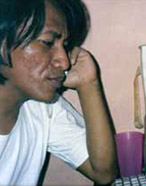 |
||
|---|---|---|
| CP Foundation | About CP Biennale | 2003 | 2005 | Contact Us | >||
           
|
||
|
The awareness about the flat character of a painting marks an important period in Nurhidayat's creative process. In the beginning, he was interested in the methods of technical drawings and the pictures in packaging boxes. Thus, he moved from painting objects with the three-dimensional perspective to creating two-dimensional outlines of things. He creates pictorial representations of the painting, moving from its illusive aspect to the "real" one based on flat forms. Nurhidayat strengthens the massive nature of the painting plane by using a background that resembles a rusted, metallic plane without the slightest interest to create an illusion of depth. The three-dimensional nature of things is further undermined by dividing his canvas in order to paint one particular object. As the relations among objects created by their existence on the same planar level, the illusiveness and the three-dimensional nature of the painting are reduced. The level background, the outlining of objects, and the division of the plane of the canvas result in a strong flat impression in Nurhidayat's works. Nurhidayat shows how artists can logically be impulsive towards the signs around them. The awareness about the multitextual potentials of the signs, however, enables the artists to become not only consumptive, but also productive. Nurhidayat has started from merely copying and pasting images on his canvas, as it were, but he then found out how such passive nature could turn into an active act to reconstruct some visual representations of the objects. We will find in his works how technology and the world of machines are identical with mechanizations. We can see the paradox when the highly rational realm is portrayed with "rusted" background and in a "primitive" way. Instead of using digital prints on his canvas--or at least some rulers, perhaps--Nurhidayat uses only his brush and hands to create the outlines of those objects. Nurdian Ichsan Born on July 29, 1973 in Kuningan. SELECTED SOLO EXHIBITIONS SELECTED GROUP EXHIBITIONS |
||
|
CP Foundation | About CP Biennale | 2003 | 2005 | Contact Us
Jl. Suryopranoto 67A, Jakarta 10160, Indonesia. ph. +62.21.3448126, 3853206 | fax. +62.21.3853203, 3853208 info@cp-foundation.org |
||
 The attitude to pick and transfer things on the canvas dominates Nurhidayat's works. He calls it an urge to create a collage, or it can widely be perceived as a general tendency to pick up signs or texts in order to use them artificially later on. Such impulsive and artificial nature makes what Nurhidayat is doing different from appropriation. Just like other artists have personal memories about objects and signs, Nurhidayat, too, has his own memories about his sewing machine. Associations with the function and the kinds of the machine continually enrich Nurhidayat's visual vocabulary. An object is always open to all kinds of associations. Thus, the sewing machine is related with the texts on domesticity, femaleness, old-fashioned, semi-manual and semi-industrial work. With these relations, Nurhidayat starts to create taxonomy on things and include a coffee grinder and a chili grinder in his work. The process goes on to include a microscope, an elevator, a train, and so on.
The attitude to pick and transfer things on the canvas dominates Nurhidayat's works. He calls it an urge to create a collage, or it can widely be perceived as a general tendency to pick up signs or texts in order to use them artificially later on. Such impulsive and artificial nature makes what Nurhidayat is doing different from appropriation. Just like other artists have personal memories about objects and signs, Nurhidayat, too, has his own memories about his sewing machine. Associations with the function and the kinds of the machine continually enrich Nurhidayat's visual vocabulary. An object is always open to all kinds of associations. Thus, the sewing machine is related with the texts on domesticity, femaleness, old-fashioned, semi-manual and semi-industrial work. With these relations, Nurhidayat starts to create taxonomy on things and include a coffee grinder and a chili grinder in his work. The process goes on to include a microscope, an elevator, a train, and so on.